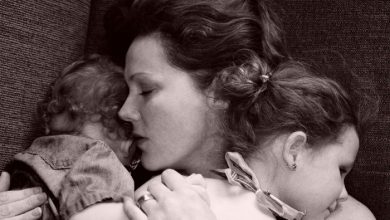
How to feel confident about your child’s Type.
You’ve noticed that your child has a lower-movement energy. But do they express soft, snuggly Type 2 energy? Or more serious, still Type 4 energy?
In this episode, Carol and Anne help you see the difference between Type 2 and Type 4 children in Carol’s Energy Profiling system. They share personal examples, along with tips of what to look for. Listen in and you’ll have info to help you be sure about your more introverted child’s Type.
This episode’s Parenting Practice
If you are unsure about your child’s Type, take the time to talk to them about it, help them determine with you. Rewatch the facial profiling videos or watch them for the first time if you haven’t. Set the intention that you will recognize their Type. If you already know your child’s Type, ask yourself how you can support that child in expressing their soft or serious nature.
Transcript of podcast episode
Carol: Welcome to The Child Whisperer podcast. I’m your host Carol Tuttle, author of the best selling parenting book, The Child Whisperer. I’m with my co-host, Anne Tuttle Brown.
As you’ve come to learn as a child whispering parent, in the 4 Types, there are two Types that are considered the lower movement and a more introverted energy, meaning the energy moves inward. And that is your Type 2 child who has a more sensitive nature and a quality of moving inward to see how they feel about things, they feel their way through life. And then your Type 4 child who is a more intellectual, more serious child that has an inward quality of going into an analytical, intellectual process, but they’re both a lower movement that they have a quality of just being satisfied with just less movement going on in their lives. So it doesn’t mean they sit around or they’re not busy, or they’re engaged in activities, it just means there’s a lesser degree of it and…
Anne: They’re what we call the introverts. Their movement goes inward, they have a process of reflection, connection. And so what’s the difference when it comes to 2 and 4 and that sometimes can get tricky. You know your child is a lower movement but is it the 2 or the 4?
Carol: So I would say the two words that stand out for me if I just were to describe the movement, generally speaking, as an overall quality, Type 2 movement has a softness to it, and Type 4 movement has more of a structure, a rigidity. It’s just stiffer, it’s not as soft, as melty.
Anne: And you can even see this in their body language, you know, does your child have more of a rigid posture versus a melty, snuggly posture? And body language and facial features will be so supportive when you’re at that point of, “I gotta nail this, what’s their dominant?” So make sure you’ve watched or rewatched the facial feature videos that we have on The Child Whisperer blog to just really see those and be able to identify the differences. And then also, you can see it a lot in how they speak, when it comes to Type 2 and Type 4. Type 2 can have a mumble, a softer voice, sometimes a little bit of a whiny quality even. Type 4 uses precise language. Maybe they don’t speak as much. Maybe they’re more private with their words, or they’re very bold in their words. And so language, when it comes to this group, can be a sign as well.
Carol: If you were to take their keywords, Type 2, sensitive, gentle, soft, subtle. Can they get loud at times? Certainly. They can have upsets, they can get outspoken at times because their needs are not being met. But overall, I consider a Type 2 child as kind of a little bit like a squishy toy. They’re just huggable, they’re just a softness.
Anne: And well I have three kids, two are Type 3s, one Type 2, he’s still like my most melty you know, he’s like…
Carol: Yeah. He’s just a gentle soul.
Anne: …as a baby, he would just…
Carol: A gentleness about him.
Anne: …melt onto me. My Type 3 is never…my little Type 3, he’s not a snuggler. He’s like, “Just put me in bed. Let’s get this job done.”
Carol: Yeah, he is laying down. I’m like, “You already put him to bed?”
Anne: And still like…
Carol: Like yeah, you just go like, “Goodnight.”
Anne: I try. I’m like, “You want me to hold you?” And he’s like, “Well, for like maybe a minute,” but then he’s like, “Well, it’s just we’re doing bedtime you know?”
Carol: “I’m going to go to bed.”
Anne: But that’s…obviously that’s 2 versus 3. But even when it comes to Type 4, she has two Type 4s, her first Type 4 was straight back. And Jenny’s Type 4 was like rock in the back baby, like I don’t… And then that Type 2 is just like fall over melts in your arms. So there’s definitely a difference there. And you can think back to those when they were a baby and did you notice the difference.
Carol: You’ll hear things, like this is a perfect example of my Type 4 grandson who is the oldest grandchild. He’s almost 13. His Type 3 brother who’s just a couple years younger than him would love to have a pet, like a dog. And he’s very clear on and very matter of fact on that, “If you get a dog, I’m moving into an apartment because I do not like hair.” I’m like, “There you go.”
Anne: Maybe he’d like an apartment.
Carol: That’s what you’re looking for. These like…that’s a bold opinion. That’s very defined. That’s clear. It’s like okay, and the fact that he doesn’t want hair around. That’s a preference to him. Not all…you know, they’re the all-or-nothing child. That’s where someone recently posted in The Child Whisperer Facebook group, “Why do I care more about my child’s, you know, clothes being clean than they are and they’re the Type 4?” And we’ve talked about that a fair amount, especially in our Lifestyle content. If it’s not a value to them, they’re in the nothing space with it, meaning that’s not important, I’m not going to give my attention to that. But the things they value, they’re very, very mad…exact with…
Anne: Particular about it.
Carol: …and particular and want a certain perfectionistic outcome. So their keyword is serious, precise, structured, authoritative, rigid. Very different than your soft, subtle, relaxed, gentle, but the fact is you’ll get confused by the slower movement quality, but they’re very different qualities of movement.
Anne: You know, we did a previous podcast on Type 3 or Type 1 energy and I feel like that group gets a little bit more confusing than the 2 and the 4 because it…yeah.
Carol: Yeah, these to me are real easy because a Type 4 child is very…
Anne: Very clear.
Carol: …they’re very Type 4 typically.
Anne: I think it’s when you bring in a secondary. And so we recently did a podcast on secondaries, so make sure you’ve listened to that. There’s this great story from a parent from The Child Whisperer Facebook group, “I have to Type 4 sons. I had a hard time deciding if the younger one was a Type 2 or a Type 4. He couldn’t be a 4 because he wasn’t exactly like his older brother, even though he was alike in so many ways. When I showed him videos and asked him, he told me he was a Type 4. I doubted but then I watched his posture and his straight back in poses for pictures and it was a dead giveaway. I should have trusted him. But I’m seeing the difference in the secondary with a 4/3 and a 4/2.” So she’s got her older son’s a 4/3, and this one that she thought maybe was a 2 was a 4/2.
Carol: My son has the Type 4 trifecta. He’s the dad as a 4/3. He has a 4/1 and a 4/2. And it’s been fascinating to kind of watch those variables between them all that those secondaries that you can learn more about in that podcast just kind of give it a little different flavor. They’re all very Type 4, there’s a common theme for all of them, but just a little bit variable for each of them.
Anne: And the 4/2 was more snugly than the 4/1.
Carol: Oh, very much.
Anne: And interesting, the other example that we have to share is about a 4/2. So maybe it’s when you get to that, the 2/4 or the 4/2, that it becomes a little bit trickier. She says, “My other daughter is a 4/2 and in the beginning, I thought she was a 2 because she had so many feelings and loved soft things, but her face is very 4.” So there you go again, facial features. “I asked her what she thought and she typed herself as a 4 so I went with it.” Both times the child knew. “So she was right on. In all honesty, it was my lack of understanding this sweet daughter that I even read “The Child Whisperer.” She is exactly opposite of my Type 1/3 firstborn and unlike anyone in my family. So I needed a manual to relate. Now that I know her need for extreme privacy, I even asked her if I could post this,” that’s really cute.
Carol: That’s awesome.
Anne: “And understand her better, our relationship is so much more amazing.” Notice how on both of these stories, they ask their children. I love that they brought them into it and the children both knew and I think especially as a Type 4 because they’re clued into this, they’ll take the time to reflect and say, “I’m a Type 4 and I know it,” and as a parent trusting that. I love those stories, how they relate so much.
Carol: My experience in meeting Type 4 children, there’s a lot of Type 4 children out there that are so grateful their parents understand this about them because they really have this great need to be respected and understood and given that right to authority. In fact, one of my favorite experiences with a Type 4 little boy, nine-year-old. He came to two of my book signings, and he was so enamored to meet me and he had his own business card. And he wanted his picture with me, and he was just thrilled that his parents knew this about him. And it was just so endearing to see this little boy who knew himself so well. So in this case, your Type 4 children in so many stories we’ve heard that they’ll identify with the information and say, “Yes, that’s me.”
Anne: Your parenting practice for this week is if you are undecided about your children’s Type, take the time to talk to them about it, help them determine with you. Rewatch the facial profiling videos or watch them for the first time if you haven’t, and really get clear. Set the intention that it will be shown to you so you can support your children in living their truth.
Carol: Thanks for listening. For more support, go to thechildwhisperer.com where you can purchase the book, subscribe to our weekly parenting practice email, and find a transcription and audio of, “The Child Whisperer” podcast.
Anne: If you’re listening on iTunes, thank you for leaving a review. If you have a parenting question, please send it to [email protected].



